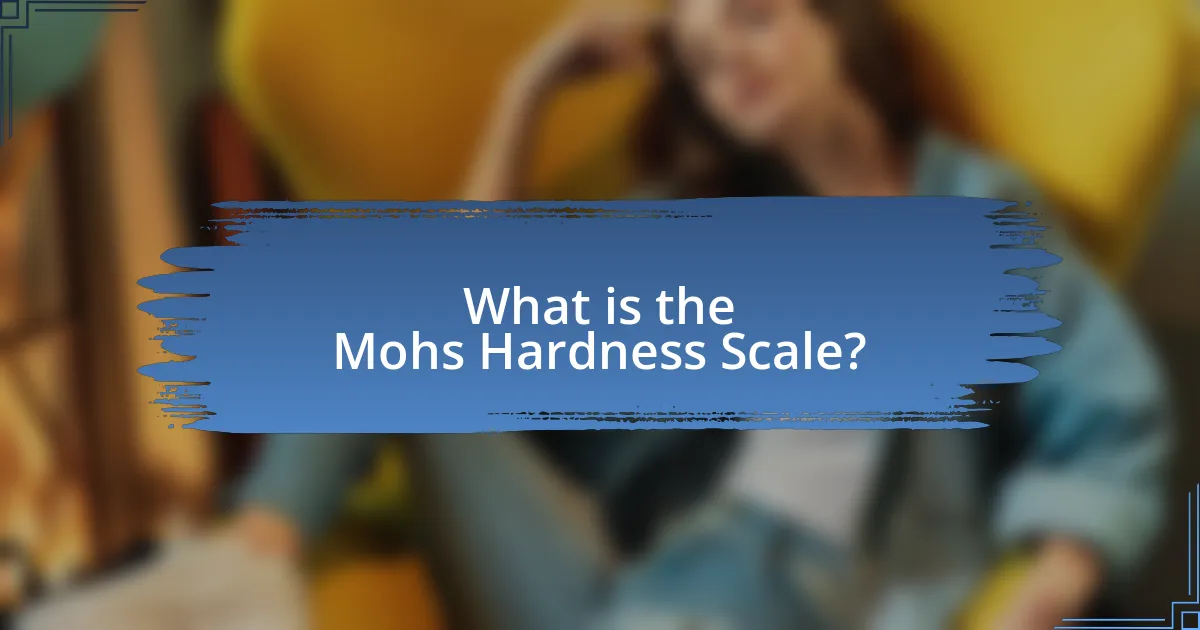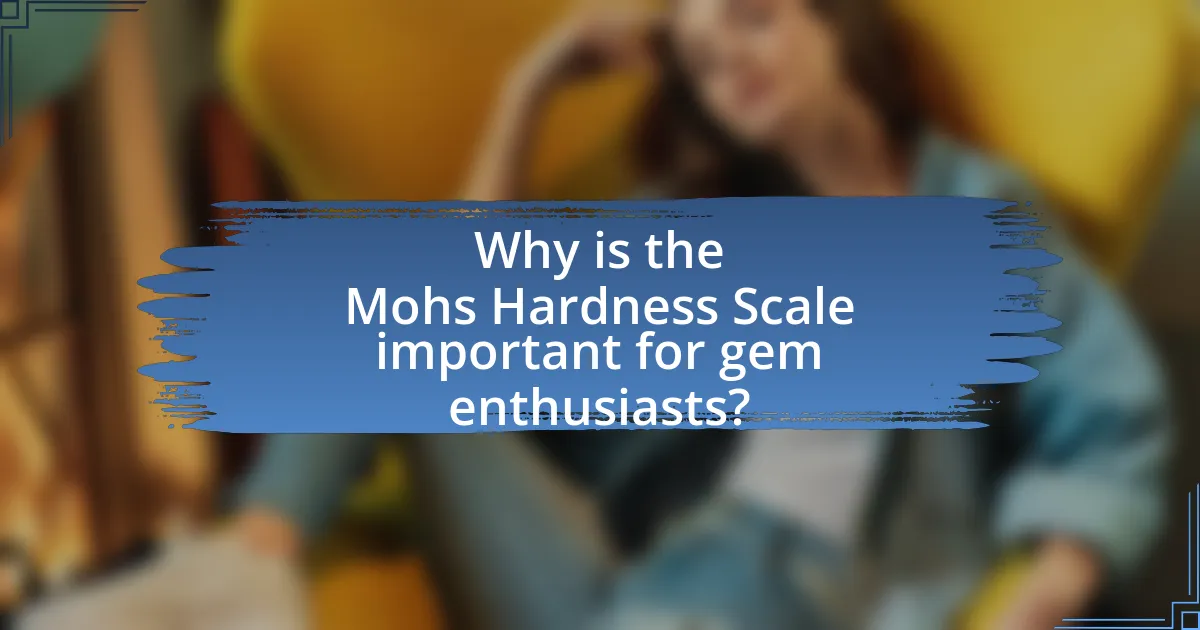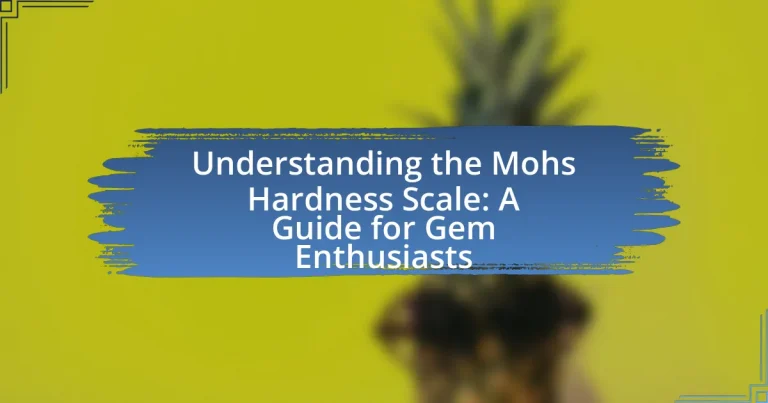The Mohs Hardness Scale is a qualitative tool developed by Friedrich Mohs in 1812 to measure the hardness of minerals based on their ability to scratch one another, ranging from talc (1) to diamond (10). This scale is essential for gem enthusiasts as it aids in identifying and classifying gemstones by assessing their scratch resistance, which directly impacts their durability and suitability for various applications. The article explores the development, key features, practical applications, and limitations of the Mohs Hardness Scale, providing insights into how it assists in gem identification and care. Additionally, it discusses best practices for effectively using the scale in real-world scenarios.

What is the Mohs Hardness Scale?
The Mohs Hardness Scale is a qualitative scale used to measure the hardness of minerals based on their ability to scratch one another. Developed by Friedrich Mohs in 1812, the scale ranges from 1 to 10, with talc rated as 1 (the softest) and diamond rated as 10 (the hardest). This scale provides a simple way to compare the hardness of various minerals, aiding in identification and classification in geology and gemology.
How was the Mohs Hardness Scale developed?
The Mohs Hardness Scale was developed by Friedrich Mohs in 1812 as a method to rank minerals based on their scratch resistance. Mohs, a German geologist and mineralogist, created the scale by selecting ten reference minerals, each representing a specific hardness level, ranging from talc (the softest) to diamond (the hardest). This scale allows for the comparison of the hardness of various minerals, facilitating identification and classification in geology and gemology. The selection of minerals was based on their ability to scratch one another, establishing a relative hardness scale that remains widely used today.
Who created the Mohs Hardness Scale and why?
The Mohs Hardness Scale was created by Friedrich Mohs in 1812 to provide a simple and practical method for classifying minerals based on their hardness. Mohs developed the scale by selecting ten reference minerals, each representing a specific hardness level, allowing for easy comparison and identification of other minerals based on their ability to scratch or be scratched by these reference points.
What criteria were used to establish the scale?
The criteria used to establish the Mohs Hardness Scale include the ability of a mineral to scratch another mineral and its resistance to being scratched. This scale ranks ten minerals from talc, the softest, to diamond, the hardest, based on their scratch resistance. The scale was developed by Friedrich Mohs in 1812, who selected common minerals that represented a range of hardness levels, allowing for easy comparison and identification in the field of mineralogy.
What are the key features of the Mohs Hardness Scale?
The Mohs Hardness Scale is a qualitative scale that ranks minerals based on their ability to scratch one another, ranging from 1 (talc) to 10 (diamond). This scale is widely used in geology and mineralogy to assess the hardness of various materials, providing a simple reference for identifying minerals. Each mineral on the scale can scratch those below it and can be scratched by those above it, establishing a clear hierarchy of hardness. The scale was developed by Friedrich Mohs in 1812 and remains a fundamental tool in the study of minerals, allowing for easy comparison and identification based on hardness.
How does the scale measure hardness?
The Mohs Hardness Scale measures hardness by ranking minerals based on their ability to scratch one another. This scale assigns a value from 1 to 10, with talc at 1 (the softest) and diamond at 10 (the hardest). Each mineral can scratch those with lower numbers and is scratched by those with higher numbers, providing a relative measure of hardness that is easy to use for identification purposes in gemology.
What is the range of hardness levels on the scale?
The range of hardness levels on the Mohs hardness scale is from 1 to 10. This scale categorizes minerals based on their ability to scratch one another, with talc rated as 1 (the softest) and diamond rated as 10 (the hardest). Each level represents a specific mineral, providing a reference for comparing the hardness of various materials.

Why is the Mohs Hardness Scale important for gem enthusiasts?
The Mohs Hardness Scale is important for gem enthusiasts because it provides a standardized measure of a mineral’s resistance to scratching, which is crucial for assessing the durability and suitability of gemstones for various applications. This scale ranks minerals from 1 (talc) to 10 (diamond), allowing gem enthusiasts to compare the hardness of different stones and make informed decisions regarding their care and usage. For example, knowing that sapphires have a hardness of 9 helps enthusiasts understand that they are more resistant to scratches than quartz, which has a hardness of 7. This knowledge aids in selecting appropriate settings and maintenance practices for jewelry, ensuring longevity and preserving the aesthetic value of the gems.
How does the Mohs Hardness Scale assist in gem identification?
The Mohs Hardness Scale assists in gem identification by providing a standardized method to measure and compare the hardness of minerals, which is crucial for distinguishing between different gemstones. This scale ranks minerals from 1 (talc) to 10 (diamond) based on their ability to scratch one another, allowing gemologists to identify stones by testing their resistance to scratching. For example, if a gemstone can be scratched by a mineral rated 7 on the scale, it is likely to be softer than that mineral, aiding in its classification. The scale’s simplicity and effectiveness make it a fundamental tool in gemology, as it helps in verifying the authenticity and quality of gemstones based on their hardness characteristics.
What role does hardness play in distinguishing gemstones?
Hardness is a critical factor in distinguishing gemstones, as it determines a gem’s resistance to scratching and abrasion. The Mohs Hardness Scale, which ranks minerals from 1 (talc) to 10 (diamond), provides a standardized measure of hardness that helps gemologists identify and classify gemstones. For example, sapphires and rubies, both rated at 9 on the scale, are significantly harder than quartz, which is rated at 7. This hardness not only affects the durability and wearability of gemstones but also influences their market value, with harder stones generally being more sought after due to their longevity and resistance to damage.
How can the scale help in assessing gemstone durability?
The Mohs Hardness Scale helps in assessing gemstone durability by providing a standardized measure of a mineral’s resistance to scratching. This scale ranks minerals from 1 (talc) to 10 (diamond), indicating their relative hardness. For example, a gemstone rated 7 on the scale, like quartz, can withstand scratches from materials rated lower than 7, thus demonstrating its durability in everyday wear. The scale’s systematic approach allows gem enthusiasts to compare the hardness of different gemstones, aiding in the selection of stones suitable for various applications, such as jewelry, where durability is crucial.
What practical applications does the Mohs Hardness Scale have?
The Mohs Hardness Scale has practical applications in identifying minerals and assessing their durability for various uses. Geologists utilize the scale to classify minerals based on their scratch resistance, which aids in field identification and educational purposes. Additionally, jewelers apply the scale to evaluate gemstones, ensuring they select appropriate materials for jewelry that can withstand wear and tear. The scale also informs industries such as construction and manufacturing, where material hardness is crucial for selecting suitable components for tools and machinery. For instance, diamonds, rated as a 10 on the scale, are used in cutting tools due to their exceptional hardness, while softer minerals like talc, rated as a 1, are used in products like talcum powder.
How is the scale used in the jewelry industry?
The Mohs Hardness Scale is used in the jewelry industry to assess the scratch resistance of gemstones and materials. This scale ranks minerals from 1 to 10 based on their ability to scratch one another, with talc at 1 (softest) and diamond at 10 (hardest). Jewelers utilize this scale to determine the durability of gemstones, guiding decisions on appropriate settings and care. For example, a gemstone rated 7 on the Mohs scale, like quartz, is suitable for everyday wear, while a softer stone, such as opal rated at 5.5 to 6, may require more careful handling to avoid scratches.
What are the implications of hardness in gemstone care?
Hardness in gemstones significantly impacts their care and maintenance. Gemstones with higher hardness ratings on the Mohs scale, such as diamonds (10) and sapphires (9), are more resistant to scratches and damage, allowing for easier cleaning and longer-lasting wear. Conversely, softer gemstones like talc (1) and gypsum (2) require more careful handling and storage to prevent scratches and deterioration. For instance, a softer stone may need to be stored separately from harder stones to avoid damage. This understanding of hardness helps gem enthusiasts make informed decisions about cleaning methods, storage solutions, and overall care practices, ensuring the longevity and beauty of their gemstones.

What are the limitations of the Mohs Hardness Scale?
The Mohs Hardness Scale has several limitations, primarily its qualitative nature and the lack of a uniform measurement system. The scale ranks minerals from 1 (talc) to 10 (diamond) based on their ability to scratch one another, but it does not provide precise numerical values for hardness, making comparisons between minerals less accurate. Additionally, the scale is not linear; the difference in hardness between minerals is not consistent, as the jump from 9 (corundum) to 10 (diamond) represents a much larger increase in hardness than between lower-ranked minerals. Furthermore, the scale does not account for other factors affecting hardness, such as crystal structure and environmental conditions, which can influence a mineral’s performance in practical applications.
What are the criticisms of the Mohs Hardness Scale?
The Mohs Hardness Scale is criticized for its lack of precision and subjective nature. Critics argue that the scale’s ordinal ranking does not provide a quantitative measure of hardness, making it difficult to compare minerals accurately. Additionally, the scale is based on ten reference minerals, which may not represent the full range of hardness in natural materials. This limitation can lead to inconsistencies in hardness testing, as the scale does not account for variations in mineral composition or structure. Furthermore, the scale’s reliance on scratch tests can be misleading, as some materials may exhibit different hardness levels depending on the testing conditions.
Why might the scale be insufficient for certain materials?
The Mohs Hardness Scale may be insufficient for certain materials because it does not account for the complexities of hardness beyond simple scratch resistance. For example, materials like diamonds, which rank highest on the scale, can exhibit different hardness characteristics under varying conditions, such as pressure or temperature. Additionally, the scale does not differentiate between types of hardness, such as indentation hardness or rebound hardness, which can be crucial for understanding the performance of materials in practical applications. This limitation is evident in industrial contexts where materials may behave differently than expected based solely on their Mohs rating.
How does the scale compare to other hardness testing methods?
The Mohs Hardness Scale is a comparative tool that ranks minerals based on their scratch resistance, ranging from talc at 1 to diamond at 10. Unlike other hardness testing methods, such as the Vickers or Rockwell tests, which measure hardness through indentation and provide quantitative values, the Mohs scale offers a qualitative assessment based on the ability of one mineral to scratch another. This simplicity makes the Mohs scale particularly useful for gem enthusiasts who require a quick and practical reference for identifying minerals without specialized equipment. The scale’s effectiveness is supported by its historical use since 1812, allowing for consistent comparisons across various mineral specimens.
How can gem enthusiasts effectively use the Mohs Hardness Scale?
Gem enthusiasts can effectively use the Mohs Hardness Scale by assessing the scratch resistance of minerals to determine their durability and suitability for various applications. The scale ranks ten minerals from talc (1) to diamond (10), allowing enthusiasts to compare the hardness of gems against these reference points. For instance, a gem rated 7 on the scale can scratch minerals rated 6 or lower, indicating its relative strength. This practical application helps gem enthusiasts select appropriate stones for jewelry, ensuring that softer stones are not used in high-wear items. Understanding the Mohs Hardness Scale also aids in identifying gems, as hardness is a key characteristic in gemology.
What tips can help in accurately determining a gemstone’s hardness?
To accurately determine a gemstone’s hardness, utilize the Mohs Hardness Scale, which ranks minerals from 1 (talc) to 10 (diamond). Begin by selecting a reference material with a known hardness, such as a fingernail (2.5), a copper penny (3.5), or glass (5.5). Scratch the gemstone with the reference material; if the gemstone is scratched, it is softer than the reference, and if it scratches the reference, it is harder. This method is validated by the consistent performance of the Mohs scale in mineralogy, where each mineral’s hardness is established through empirical testing.
How can one apply the Mohs Hardness Scale in practical scenarios?
The Mohs Hardness Scale can be applied in practical scenarios by assessing the scratch resistance of minerals and gemstones, which helps in identifying and classifying them. For instance, gem enthusiasts can use the scale to determine the durability of a gemstone for jewelry by comparing its hardness to common materials; a diamond, rated 10 on the scale, can scratch all other minerals, indicating its suitability for everyday wear. Additionally, the scale aids in mining and material selection, as harder minerals may require different extraction techniques compared to softer ones, ensuring efficiency and safety in operations.
What are the best practices for using the Mohs Hardness Scale?
The best practices for using the Mohs Hardness Scale include understanding the scale’s range from 1 (talc) to 10 (diamond), accurately identifying minerals based on their scratch resistance, and using a consistent method for testing hardness. To effectively utilize the scale, one should conduct scratch tests with reference minerals or tools that correspond to specific hardness levels, ensuring that the testing surface is clean and free of contaminants. Additionally, it is important to recognize that the Mohs Hardness Scale is not linear; the difference in hardness between minerals increases as the scale progresses, which means that a mineral rated 9 is significantly harder than one rated 8. This understanding aids in making precise comparisons and assessments of mineral hardness.


